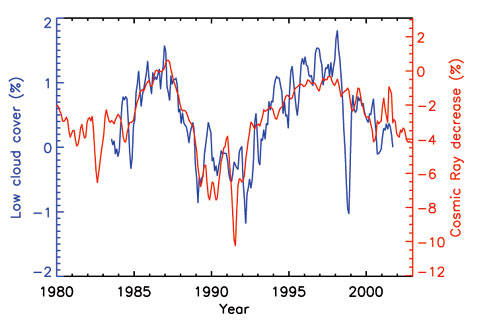miniTAX wrote:okie wrote: Estimated increases since 1675 are 0.7%, 0.2% and 0.07% in broad ultraviolet, visible/near infrared and infrared spectral bands, with a total irradiance increase of 0.2%."
Does this irradiance factor translate into a thermal increase of 0.2%?
A simple answer is N0! If 0,2% x 288°K is about 0,6°K it is just by chance.
It can't be correct because
1. temperature increase since 1675 is more than 0,6°K. It is about 1°K (or 1°C as long as we talk about diffenrences)
I understand that. That is why I dampened the effect by estimating we are maybe .10 to .15% over the average now. I would need to do more reading of the literature to come up with a more exact estimate of where we are now in terms of irradiance over the average irradiance, as relates to the same time period of measuring average earth temperatures.
Quote:2. your putative "link" is broken if you use °F
Seems like the same principle on a different scale of measurement, you just plug in absolute zero of -459 F.
Quote:3. UV energy is far from negligible so is its increase, why isn't it accounted for ? Reality is made of things we can see and things we CAN'T see (trace chemical elements, radio waves, Kelvin waves, Hadley cells, UV, IR, ultra-infra sound ...). If you try to explain complex things with only things you can see, you are doomed to fail.
True in many cases, but sometimes the complex is actually seen by the simple right before our eyes. Example. Geologists attempt to search for ore deposits by many advanced methods and surveys, including various geophysical, geochemical, and geological mapping techniques, as compared to the old uneducated prospector with his mule that basically looked for "color." Prospectors found virtually all of the ore producing districts in this country more than 100 years before geologists explained the "color" with geochemical surveys that identified trace minerals, which most of the time included elevated amounts of iron, which provided the color.
Quote:
4. Temperature equilibrium is dependant of the sun, but also and mostly of the planet's atmosphere. The moon receive about the same amount of sun's energy than the Earth, yet its temperature is completely different because its atmosphere is completely different
But don't worry, there is a simple way to calculate temperature equilibrium, that is the Stefan Boltzman law. May I suggest you to read this
POV of Dr Gray, the "pope" of hurricanes where you can find a better representation of the Earth climate system and how its determine the absolute temperature and its variations (very easy to read).
As to the link to the sun to explain climate changes, I have no doubt about it, just because the CO2 "theory" is UNABLE to explain past variations whereas the solar theory can. And in the solar theory, there is not only direct effects (irradiance) but also indirect effects by cosmic rays which influences cloud formation. You have plenties of research results about it, but of course, the IPCC and media keep blind eyes on theses disturbing facts. In a nutshell: change of solar magnetic field => change of cosmic rays arriving to the Earth => change of cloud cover => change of temperature.
A good place to start discovering it is on
Nir Shaviv's blog.
See also
this discussion on the notorious alarmist blog RealClimate where Shaviv and his theory largely prevail.

Thanks for the links and the info. Agreed, there are many more factors that play into the system that controls atmospheric conditions. And the subject of amplifiers seems logical and likely. However, take the analogy of the earth and moon, and apply it to rooms in a house, all served by the same furnace. One room may have open windows, while another does not and is insulated differently, so the temperature is much lower in the drafty room, but turning the furnace up still affects all rooms, although perhaps not all to the same extent, but perhaps in roughly the same proportional amount. So just because the atmosphere of Earth has many more factors than simply receiving the sun's rays, this to me does not negate the potential ability to mathematically compute an effect of the sun. There is obviously a complex formula that would explain how all of the factors contribute, although we are far from defining such a formula with all factors, we can still observe and estimate one of the factors as being a very large component, and it would seem to me that computing the effects of irradiance lends itself to far more credibility than attempting to compute the so-called greenhouse effect, which so-called scientists are attempting to not only do, but claim to be able to do it with a high degree of confidence. I think it is total bunk. They have chosen to go down that road, I think because of a biased and desired result to their theories.
In contrast, we see simple evidence that we are now experiencing heightened solar activity, and this coupled with other phenomena, such as Mars heating up, seems to me to be a very compelling argument for a significatn solar influence on our climate here. Your links concerning cosmic rays, cloud cover, etc. is an avenue that needs much more research.
MiniTAX, thank you for your very informed and credible input into this thread. What is your profession or scientific training as pertains to this subject, if I can be nosy?